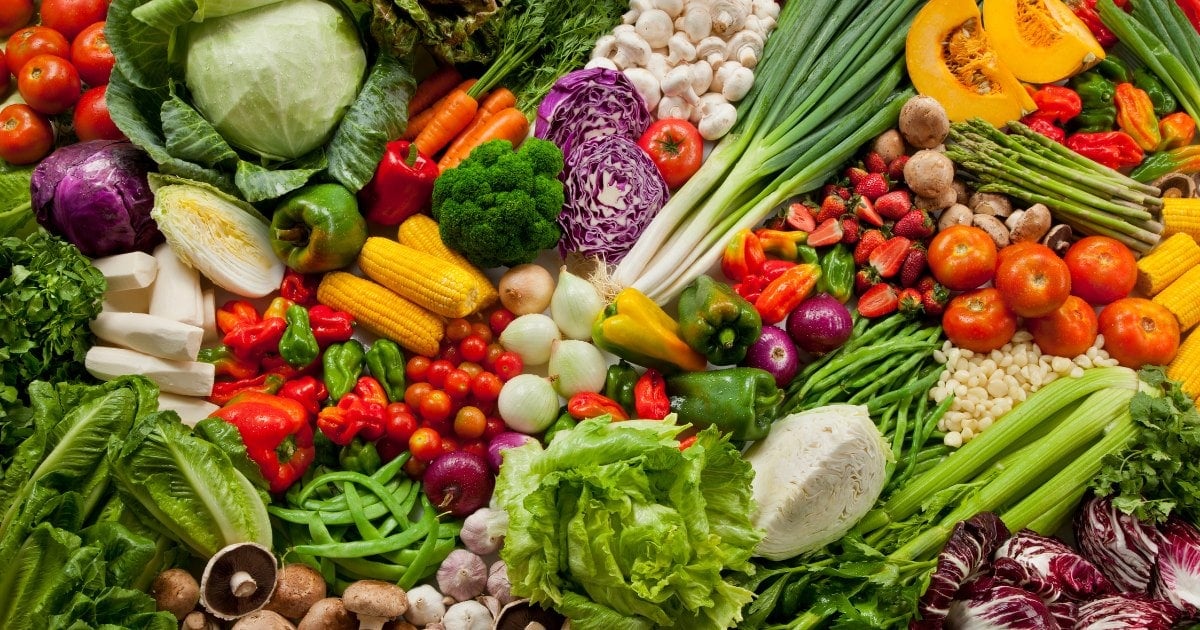All vegetables are pretty darn healthy, but eating a bowlful of corn or sweet potato is going to impact your blood sugar far more than a bowlful of broccoli or green beans.
In this article, we’ll look at 10 of the top low-carb vegetables that won’t spike your blood sugar and some that will raise your blood sugar more substantially. (But again, I’ve gotta say: there’s no such thing as a bad vegetable!)

Total carbohydrates vs. net carbohydrates
When talking about the carb quantities of different foods, it’s important to understand the difference between total carbohydrates (“carbs”) and net carbohydrates.
(It’s worth noting that “net carbohydrates” is not a regulated term, nor is it officially recognized by the U.S. Food and Drug Administration [FDA] or the American Diabetes Association [ADA].)
Total carbohydrates are the absolute total number of grams of carbohydrates in a food item. This will include added sugars (e.g., in candy, soda, cake), naturally-occurring sugars (e.g., in fruit), or starch (e.g., in potatoes, wheat, oats); sugar alcohols used in “sugar-free” products; and all types of dietary fiber.
Net carbohydrates are the total number of carbohydrates after you subtract dietary fiber and any sugar alcohols from the total carbohydrates.
Dietary fiber is theoretically not broken down into glucose like other types of carbohydrates, which means it won’t significantly impact your blood sugar.
So, to give an example, if you’re eating a meal containing 20 grams of total carbohydrate and 10 grams of fiber, the meal would have 10 grams of net carbs. If you’re counting carbs and dosing insulin based on carbs, it’s important to know how many carbohydrates will actually impact your blood sugar management.
When it comes to low-carb vegetables, identifying carb quantities by “net” carbohydrates is important when comparing one item to another because some vegetables contain far more dietary fiber than others. By subtracting that fiber amount from the total carbohydrates, it makes for a more accurate comparison.
(All that being said, however, it’s worth noting that it’s not always true that fiber and sugar alcohols aren’t metabolized, according to the ADA, so it’s important to take this approach with the proverbial grain of salt.)
Does the glycemic index (GI) still matter?
The glycemic index was created to rank every food based on the number of carbohydrates and the rate at which those carbohydrates raise blood sugar levels.
While it was very popular in the 80s after being introduced in 1981 as the determinant of which carbohydrates are healthy and which are not, it can be a little misleading for those of us with diabetes.
For instance, while grapes are a wholesome source of nutrition, they also contain a lot of sucrose compared to other fruits. Grapes are notorious in the diabetes community for their rapid impact on blood sugar levels. A mere handful of grapes can potentially raise your blood sugar by 200 mg/dL if not matched well with an insulin dose.
And yet, based on the glycemic index, grapes are considered ideal for people with diabetes because they rank in the 40s. Anything under 50 is considered a good choice for your diabetes goals.
Another example is spaghetti. According to the glycemic index, white spaghetti ranks under 50, making it an ideal choice for people with diabetes. If you’ve ever eaten a bowl of spaghetti as a person with diabetes, you know it can be anything but kind to your blood sugar and insulin needs.
The glycemic index can also be difficult to work with because the glycemic value of vegetables changes depending on how they are cooked. For example, roasted potatoes have a glycemic value of around 69 while mashed potatoes are around 78.
In this article, we did not include the glycemic index on different vegetables, because when it comes to counting carbohydrates and measuring insulin, we don’t find it is a helpful tool.
10 low-carb vegetable choices for people with diabetes
A diet full of vegetables is a healthy diet. Are you stuck in a rut of only including vegetables at dinnertime? Getting vegetables into your diet as part of a snack, lunch, and dinner (and even breakfast!) is a worthy goal.
As a general rule, vegetables that grow above ground contain fewer carbohydrates than those that grow below ground.
Here are 10 low-carb vegetable options that’ll be a great addition to your nutrition whether you’re following a ketogenic (“keto”) or other low-carb diet or simply as a person with diabetes managing your blood sugar.
Learn more about the keto diet in: The Ketogenic Diet and Diabetes: The Definitive Guide.
Bell pepper
There are a variety of tasty bell pepper colors, but the lowest in carbs are the green ones. That being said, don’t shy away from red, orange, and yellow — their carb count is still relatively low, and they offer a great variety of vitamins and minerals.
Key nutrition facts, 1 cup of raw green bell pepper, chopped:
Calories: 29.8
Carbs: 6.91 g
Protein: 1.28 g
Fat: 0.25 g
Fiber: 2.53 g
Net carbs: 4.38 g
Broccoli
Broccoli is a great way to fill your belly without many carbs or calories. A wonderful replacement for pasta, you can fill your plate with broccoli, a small portion of meat, and other low-carb veggies and you’ll be pretty satisfied.
Key nutrition facts, 1 cup of raw broccoli. chopped:
Calories: 30.90
Carbs: 6.04 grams (g)
Protein: 2.57 g
Fat: 0.34 g
Fiber: 2.37 g
Net carbs: 3.67 g
Brussels sprouts
These delicious sprouts are very nutritious but can require a bit of chopping if used fresh. They have a pretty strong scent and flavor when cooked, too, which can unfortunately prevent some people from trying them. I recommend chopping each sprout in half, drizzling with olive oil and salt, and roasting them in the oven.
Key nutrition facts, 1 cup of cooked Brussels sprouts:
Calories: 56.2
Carbs: 11.08 g
Protein: 3.98 g
Fat: 0.78 g
Fiber: 4.06 g
Net carbs: 7.02 g
Cabbage
Cabbage — red or green — is a great way to fill up your plate with a lot of nutrition but without many carbs. Sautéed with onions and chopped-up green beans, you’ll find that what looks just like lettuce actually has a great deal of flavor — it’s great with a little meat, too. Mix it up between red and green for variety!
Key nutrition facts, 1 cup of raw red cabbage, chopped:
Calories: 22.2
Carbs: 5.16 g
Protein: 1.14 g
Fat: 0.09 g
Fiber: 2.22 g
Net carbs: 2.94 g
Cauliflower
There’s a reason everybody keeps substituting “riced cauliflower” for rice — it’s extremely low-carb and very filling. Whether you eat it steamed, sautéed, or “riced,” it can be pretty tasty with herbs, spices, salt, and pepper.
Key nutrition facts, 1 cup of raw cauliflower, chopped into 1/2-inch pieces:
Calories: 26.8
Carbs: 5.32 g
Protein: 2.05 g
Fat: 0.30 g
Fiber: 2.14 g
Net carbs: 3.18 g
Celery
Celery is light, crunchy, flavorful, and a really delicious vehicle for peanut butter. You can use it in soups, veggie salads, and more as a low-carb, whole-food filler.
Key nutrition facts, 1 cup of raw celery, chopped:
Calories: 14.10
Carbs: 3.00 g
Protein: 0.70 g
Fat: 0.17 g
Fiber: 1.62 g
Net carbs: 1.38 g
Eggplant
My favorite way to eat eggplant is by slicing it up, brushing it with a little oil, sprinkling with paprika and salt, and then air-frying it to create chips. Eggplant chips are extremely low-carb. You can also just cube an eggplant and bake it with a little salt and pepper.
Key nutrition facts, 1 cup of raw eggplant, cubed:
Calories: 20.5
Carbs: 4.82 g
Protein: 0.81 g
Fat: 0.15 g
Fiber: 2.46 g
Net carbs: 2.36 g
Green beans
A little starchier than other veggies on this list, green beans are still worth their place in your diet. With this veggie, you may find the impact on your blood sugar to be less than what the carb count implies.
Key nutrition facts, 1 cup of raw snap green beans, cut into 1/2-inch pieces:
Calories: 31
Carbs: 6.97 g
Protein: 1.83 g
Fat: 0.22 g
Fiber: 2.70 g
Net carbs: 4.27 g
Leafy greens (e.g., spinach, romaine, Swiss chard, kale, iceberg lettuce, etc.)
You can’t eat too many leafy greens. Loaded with vitamins and minerals (and a surprisingly great source of calcium for bone health), these should undoubtedly be a part of any healthy diet — especially for people with diabetes.
The darker the green in those leaves, the more nutrition.
Key nutrition facts, 1 cup of raw spinach:
Calories: 23.00
Carbs: 3.63 g
Protein: 2.86 g
Fat: 0.39 g
Fiber: 2.20 g
Net carbs: 1.43 g
Onions
It’s hard to report the number of carbs in an onion because you generally only eat a few slices at a time in your sandwich or in a stir-fry. Sure, 1 cup contains about 15 grams of carbs, but how many people eat 1 cup of onions in a sitting? A medium slice of onion, on the other hand, contains only 1.31 grams of carbs and 1.07 grams of net carbs.
Key nutrition facts, 1 cup of raw onions, chopped:
Calories: 64
Carbs: 14.9 g
Protein: 1.76 g
Fat: 0.16 g
Fiber: 2.72 g
Net carbs: 12.18 g
Embracing variety and flavor
What about all of the other veggies we didn’t include on this list? You should feel free to eat those, too. Aside from keeping an eye on how much of the starchy ones you eat, you can’t go wrong with vegetables.
Look up the carb count before trying something new, and check your blood sugar within 2 hours after eating to see the impact on your blood sugar.
And remember, learning how to cook and season vegetables with herbs, spices, and sea salt can make any veggie remarkably delicious. Embrace your kitchen!
Find out about low-carb fruits in: Low-Carb Fruits: 10 Fruits With the Least Sugar.
Six vegetables that will raise your blood sugar
Just because a vegetable is on this list does not mean you can’t eat it. However, when choosing the foods on this list, it’s important to keep an eye on just how much you’re eating. If we’re going to eat carbs, certainly choosing whole-food carbs like starchy vegetables is certainly better for our overall health than, say, cupcakes.
But whether you’re on insulin or not, you’ll want to make sure you account for those extra carbs. Check your blood sugar 2 hours after eating to see how your body is handling it and reduce your carb intake at other meals, as needed, to stay within your goal carbohydrate range.
Butternut squash
Often considered a healthy alternative to mashed potatoes, it’s important to note that butternut squash still contains a decent amount of starch that can easily raise your blood sugar.
Key nutrition facts, 1 cup of baked butternut squash, cubed:
Calories: 82.00
Carbs: 21.50 g
Protein: 1.84 g
Fat: 0.18 g
Fiber: 6.56 g
Net carbs: 14.94 g
Corn
Corn is delicious, but it can be very high in starch and may spike blood sugar levels quickly.
Key nutrition facts, 1 cup of boiled sweet yellow corn:
Calories: 143.00
Carbs: 31.30 g
Protein: 5.08 g
Fat: 2.24 g
Fiber: 3.58 g
Net carbs: 27.72 g
Legumes
There are so many delicious beans out there, but they are rather starchy. Fortunately, beans do have a lot of dietary fiber to offset some of the carb content, but they should still be eaten with caution and an eye on how your blood sugar levels respond.
Key nutrition facts, 1 cup of boiled black beans:
Calories: 132.00
Carbs: 23.70 g
Protein: 8.86 g
Fat: 0.54 g
Fiber: 8.70 g
Net carbs: 15.00 g
Parsnips
Probably not an option you encounter as often, parsnips are very similar to white potatoes in texture and appearance when cooked.
Key nutrition facts, 1 cup of boiled parsnips:
Calories: 71.00
Carbs: 17.00 g
Protein: 1.32 g
Fat: 0.30 g
Fiber: 3.60 g
Net carbs: 13.40 g
Potatoes
Potatoes are nearly pure starch, and while they’re certainly delicious covered in butter and salt, they can raise your blood sugar significantly.
Key nutrition facts, 1 cup of boiled potatoes with skin:
Calories: 135.80
Carbs: 31.40 g
Protein: 2.92 g
Fat: 0.16 g
Fiber: 3.12 g
Net carbs: 28.28 g
Sweet potatoes/yams
While sweet potatoes offer more vitamins and minerals compared to white potatoes, they also have a significant carbohydrate content.
Key nutrition facts, 1 cup of boiled sweet potatoes, mashed, without skin:
Calories: 249.00
Carbs: 58.1 g
Protein: 4.49 g
Fat: 0.46 g
Fiber: 8.2 g
Net carbs: 49.90 g
Enjoying starchy veggies responsibly
Remember, you can enjoy any of these vegetables, but the starch quantity in them will impact your blood sugar even though they are healthy overall. If you choose to include these options in your diet, do so with moderation and careful attention to your medications and blood sugar levels.
Try some low-carb veggies for dinner tonight with: 15 Healthy Dinner Recipes for Diabetics (Low-Carb).
Final thoughts
While low-carb vegetables offer a variety of nutrients without significantly impacting blood sugar levels, it’s important to approach higher-carb options with moderation.
Eating a wide range of vegetables not only promotes health but also adds flavor to meals. Experimenting with cooking methods and seasoning can take vegetables to new heights, making healthy eating a satisfying experience.





Beena
Thank you for all the healthy advice!
I am a type 2 diabetic and figuring out what’s good or bad for me is a challenge. So your input is great! Thank you .